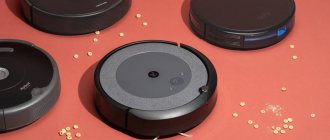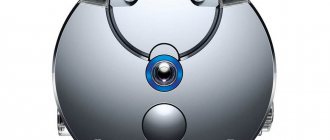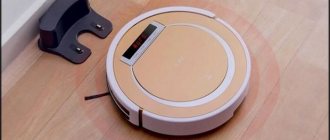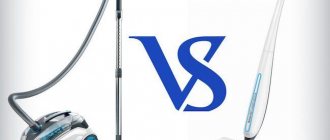Two principles of robotics
There are two key points to understand from the start:
- The main task of a robot vacuum cleaner is maintaining dry cleaning . It will not remove 100% of the garbage! It is important to set high expectations from the very beginning. No robot vacuum cleaner can clean your apartment like a hardworking housekeeper. A robot vacuum cleaner in everyday life is the embodiment of the Pareto principle. 20% of actions that bring 80% of the results. The percentage of waste collected may vary depending on the model and the specific premises. This is in any case more than 80%. And yet – once a week you clean yourself.
- The robot vacuum cleaner should be invisible to the owner . Trust me - you don't want to see him clean up. At first it is interesting to watch him. Understand the cleaning algorithm. Enjoy the reaction of your pets. Perhaps troll them a little - usually the robot’s movements can be controlled from a smartphone. But in the long run, the best strategy is to have all the cleaning done while you're away. “Set it and forget it.” Continue cleaning the dust container and brushes from time to time.
I will refer to these two principles repeatedly in this article.
Dust container volume
Image: robotvacuumcleaner.org
Due to their mobility, robots have a rather limited dust collector volume. Usually it depends on the cleaning area and ranges from 0.3 to 1 liter.
The average figure you should focus on is 0.5 liters. The smaller dust container is only suitable for small apartments and will quickly become clogged with pet hair.
There are also vacuum cleaners with garbage collectors that are built into the base. The robot unloads the contents of the dust collector there and returns to cleaning. This design is quite bulky and expensive.
What types of robot vacuum cleaners are there? Principle of operation. Navigation
There are four options - disgusting, bad, good and great robot vacuum cleaner. It will be easier to choose the best one with my analysis below:
- Disgusting . The robot moves according to a random principle .
- Bad . Navigation using a gyroscope . The robot itself remembers where it went, what distance, and how it turned. Using this information, the robot builds a map of the space around it. Roughly speaking, he has no “eyes”. If the wheels slipped or skidded, the picture of the world instantly collapsed.
- Good . Camera navigation . The robot uses the camera image to orient itself in space. The option is good. Possible disadvantages include poor performance in low-light conditions, plus some users are concerned about possible invasion of privacy. Who knows where these photos might end up. This applies, for example, to the following models: iRobot Roomba S9+, Xiaomi Mijia 1T, iLIFE W450. These are the most common models with camera-based navigation.
- Great . Lidar navigation . Two robots that I have been using for the past few months fall into this category: Xiaomi Roborock S50 and iPlus L100. Both robots build a map based on lidar data. I was guided primarily by this criterion. This is currently the best operating principle for navigation in robot vacuum cleaners. Lidar (laser range meter) is a device that uses light waves to determine the distance to objects. The device sends a laser pulse. The time it takes for the beam to reach the object and be reflected back is the distance to the object. For robotic vacuum cleaners, the lidar is located in a turret on the top of the body. The lidar rotates 360°, the robot's processor scans the received data and builds a map of the room. This technology is also used in modern self-driving cars.
Perhaps you will say: “It’s okay, I have a two-room apartment, somehow I’ll manage with simpler navigation.” But a modern robot with lidar is better than its primitive counterpart not only in navigation, but also in general cleaning quality. The fact is that for the manufacturer, the difference in the cost of “dumb” (random or with a gyroscope) and “smart” (with camera/lidar) robots is vanishingly small.
Let's consider pricing . The wholesale cost of a camera module for a robot vacuum cleaner is less than $2. The assembled lidar costs about $30.
Making a new plastic mold and modifying the software is inexpensive in terms of large-scale production from large companies. Where does such a colossal difference in price come from? Why, even within the same line, Xiaomi Roborock E4 (with a gyroscope) costs 16 thousand rubles, and Xiaomi Roborock S5 MAX (with lidar) costs 35 thousand? It's simple: manufacturers equip models with advanced navigation (camera/lidar) with higher quality spare parts. Those. a robot with a lidar is more expensive not so much because of the lidar itself, but because higher-class components are used in its manufacture.
Analyzing feedback from consumers, manufacturers found that the demand for robots with lidar is higher, and their ratings are better. Therefore, a trend has emerged on the market that manufacturers are putting higher quality components on robots with lidar. A robot with LDS is more expensive not so much because of the lidar itself, but because higher-class components are used in its manufacture.
Conclusion . Nothing is more annoying than a robot vacuum with poor navigation. Remember the second principle of robotics? “The robot vacuum cleaner should be invisible to the owner.” In this regard, robots with laser navigation are unrivaled.
Popular manufacturing brands
Among the manufacturers of robotic vacuum cleaners, the following stand out:
- iRobot. Manufacturer of smart devices - USA. The company's models are distinguished by high quality cleaning and good cross-country ability. The quality of all device parts is excellent, even though they are made in China. The company's model range includes three lines of robotic vacuum cleaners: Roomba - for dry cleaning, Scooba - for wet cleaning, Braava - floor polishers for cleaning smooth surfaces.
- iClebo. Cleaning units are produced by a company from South Korea - Yujin Robot. There are several lines of vacuum cleaners, including O5, Omega, Arte and Pop. These devices are distinguished by their stylish design, low noise level, versatility and high build quality.
- Xiaomi. These robotic vacuum cleaners combine the best qualities of their competitors, while setting the price tag for their products at half the price. The company’s most expensive device costs only 27 thousand rubles (Xiaomi Mi Roborock Sweep One).
- Neato. The manufacturer is Neato Robotics from Silicon Valley (California). The company's devices are distinguished by an improved navigation system, as well as the ability to plot the most rational cleaning route. The robots have a non-standard shape - the body is round on one side and square on the other.
- Ecovacs. Chinese manufacturer producing the Deebot line of robots. The devices are equipped with advanced navigation technologies and have all possible technical characteristics and reliability.
Selecting a robot vacuum cleaner using a mobile application
It is best to focus on robot vacuum cleaners that support the Tuya (iPlus is one of them) or its clones (Elari and some others).
The Xiaomi application does not support geolocation cleaning scenarios, plus it is a little Chinese. But in other respects it is not inferior to Tuya.
The application from iRobot is also quite working, an honest four. It is not recommended to take everything else.
To learn how to choose the right robot vacuum cleaner based on the mobile app, read our detailed instructions.
Control methods and schedule
You can give commands to the robot in three ways: using buttons on the cleaner’s body, remote control or smartphone. The first two are usually available in the most basic models, while the latter is found in more expensive cleaners. Control via a mobile application is more convenient, but by and large any method is suitable, since the program is configured once, and then the vacuum cleaner simply works.
Most robots have a useful scheduled cleaning feature. Thanks to it, you can configure the vacuum cleaner so that it is cleaned on specified days. For example, while you are at work. Smartphone support is not needed for this - all manipulations are carried out using buttons on the case or the remote control.
Wet cleaning - good, bad, miserable
Almost all modern robot vacuum cleaners in the middle and upper price ranges are equipped with a wet cleaning function. But at the same time, as they say, “there are nuances.” It is very important to choose the right robot vacuum cleaner based on this parameter.
Types of wet cleaning
Let's try to figure it out:
- Poor option . "Wet wipe." The robot comes with a cloth that fits onto the bottom of the robot. And then you wet this rag BY HAND! What happens when the robot passes 2 square meters? m. floor surface and the rag will dry? You stop the cleaning process, remove the rag and wet it again! The idea is completely absurd. Stay a kilometer away from this.
- Bad option . A flat mounted tank on the bottom of the robot.
Standard solution for Xiaomi. Why is this design of the water tank unsuccessful? A container of this shape is low-tech and therefore unreliable
- The best option . Replaceable water tank, which is installed instead of the dust collector.
iLife V7s Plus
In this design, the water tank has the shape of a regular parallelepiped. This is an order of magnitude more reliable than a flat blotch on the bottom. iLife, iPlus and a number of other manufacturers equip their robots with this configuration.
Methods for wetting a rag when wet cleaning
It is important to pay attention to this. There are two options for how water from the tank wets the rag:
- Microcapillary method (i.e., actually by gravity). You fill the water container just before cleaning and put on a cloth. Then the water flows onto the rag by gravity. The method is very unreliable - if the robot gets stuck somewhere or stops for some other reason, then all the water from the tank will gradually flow out onto the floor. As a result of such a leak, the floor covering, for example, laminate, can be damaged. For this reason, manufacturers of such robots recommend not to run wet cleaning unattended, and never leave the tank full. This applies to budget models from Xiaomi, Mijia, Eufy and other inexpensive robots.
- Using a solenoid valve . In this case, the water supply will not start until you start the wet cleaning mode. When the robot stops, the water supply stops. Added bonus: you can adjust the water flow rate to the cloth from the app. However, manufacturers still play it safe and recommend not filling the tank in advance.
But the most important thing you should know about wet cleaning is that its importance is greatly overrated . Not only is using the wet cleaning function troublesome. Its effectiveness itself is extremely low.
If they tell you in an advertisement that a robot vacuum cleaner will remove dried stains, it’s all a lie. He won't erase anything. This applies to absolutely all models.
“My baby spilled juice on the floor, I immediately started my favorite robot in wet cleaning mode, and it quickly cleaned everything up...”
If you see a review like this











